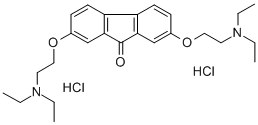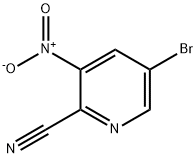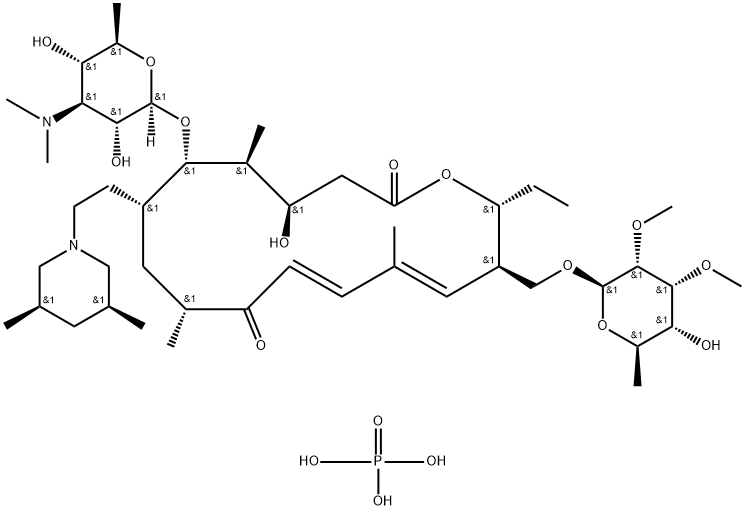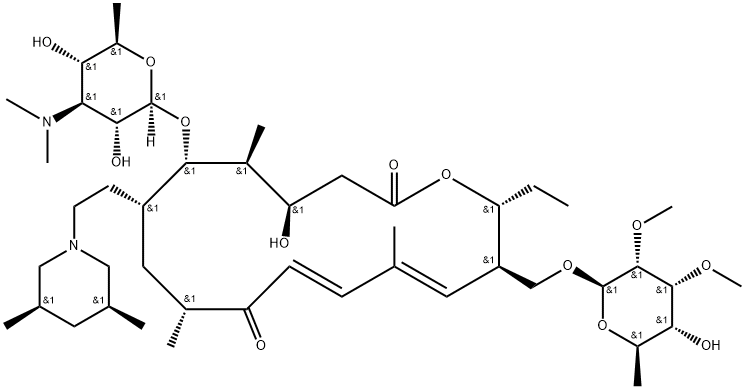Tilorone dihydrochloride
Synonym(s):2,7-Bis[2-(diethylamino)ethoxy]-9-fluorenone dihydrochloride
- CAS NO.:27591-69-1
- Empirical Formula: C25H36Cl2N2O3
- Molecular Weight: 483.47
- MDL number: MFCD00134071
- SAFETY DATA SHEET (SDS)
- Update Date: 2025-12-16 16:15:04

What is Tilorone dihydrochloride?
Description
Tilorone is an orally active, antiviral compound that induces interferon production and is reported to have antitumor, anti-inflammatory, and neuroprotective actions. With chronic administration, tilorone induces lysosomal glycosaminoglycan storage, rendering glycosaminoglycans resistant to enzymatic degradation.
Chemical properties
Orange-yellow crystalline powder
The Uses of Tilorone dihydrochloride
Tilorone dihydrochloride is an orally active, interferon-inducing antiviral agent.
The Uses of Tilorone dihydrochloride
Tilorone dihydrochloride was used to study the interaction of drugs with synthetic self-complementary DNA by SPR (Surface Plasmon Resonance).
What are the applications of Application
Tilorone dihydrochloride is A carbonyl compound is an antiviral for proteomics research
Definition
ChEBI: Tilorone dihydrochloride is the dihydrochloride salt of tilorone. It is used as an antiviral drug to treat influenza, herpes infection, viral hepatitis, acute respiratory viral infections and SARS. It has a role as an anti-inflammatory agent, an antineoplastic agent, an interferon inducer, a nicotinic acetylcholine receptor agonist and an antiviral drug. It contains a tilorone(2+).
brand name
Tilorone is INN.
General Description
Effect of tilorone dihydrochloride on the changes of transmembrane potential of mitochondrial membranes of the isolated rat hepatocytes has been investigated. Tilorone dihydrochloride is an orally active, interferon-inducing antiviral agent.
Properties of Tilorone dihydrochloride
| Melting point: | 230-233 °C(lit.) |
| storage temp. | Sealed in dry,Room Temperature |
| solubility | Methanol (Slightly) |
| form | Solid |
| color | Orange |
| Merck | 14,9440 |
| CAS DataBase Reference | 27591-69-1(CAS DataBase Reference) |
Safety information for Tilorone dihydrochloride
| Signal word | Warning |
| Pictogram(s) |
 Exclamation Mark Irritant GHS07  Health Hazard GHS08 |
| GHS Hazard Statements |
H315:Skin corrosion/irritation H319:Serious eye damage/eye irritation H335:Specific target organ toxicity, single exposure;Respiratory tract irritation H351:Carcinogenicity |
| Precautionary Statement Codes |
P280:Wear protective gloves/protective clothing/eye protection/face protection. P301+P312:IF SWALLOWED: call a POISON CENTER or doctor/physician IF you feel unwell. P305+P351+P338:IF IN EYES: Rinse cautiously with water for several minutes. Remove contact lenses, if present and easy to do. Continuerinsing. P308+P313:IF exposed or concerned: Get medical advice/attention. |
Computed Descriptors for Tilorone dihydrochloride
| InChIKey | BSVYJQAWONIOOU-UHFFFAOYSA-N |
New Products
Indole Methyl Resin tert-butyl 9-methoxy-3-azaspiro[5.5]undecane-3-carboxylate Boc-His(Boc)-OH 2-CTC Resin 4-Chloro-7-tosy1-7Hpyrrolo[2,3-d]pyrimidine 5,7-Dibromo-1H-indole 2,5-dichloro-N-hydroxy-4,6-dimethylpyridine-3-carboximidamide 2,2-Dimethoxy-7-azaspiro[3.5]nonane hydrochloride 4-chloromethyl-5-methyl-1,3-dioxol-2-one (DMDO-Cl) R-2-BENZYLOXY PROPIONIC ACID 1,1’-CARBONYLDIIMIDAZOLE 1,1’-CARBONYLDI (1,2-4 TRIAZOLE) N-METHYL INDAZOLE-3-CARBOXYLIC ACID 4-((2-hydroxyethyl)thio)benzoic acid 1-(TERT-BUTOXYCARBONYL)-2-PYRROLIDINONE Methyl 6-methylnicotinate 3-Pyridineacrylic acid tert-Butyl carbazate TETRAHYDRO-2H-PYRAN-3-OL 2-((4-morpholinophenylamino) (methylthio) methylene) malononitrile 3-(4-morpholinophenylamino)-5-amino-1H-pyrazole-4-carbonitrile 2,4-dihydroxybenzaldehyde 1,3-Diethyl-1,3-Diphenylurea Methyl 2-methylquinoline-6-carboxylateRelated products of tetrahydrofuran








You may like
-
 27591-69-1 Tilorone Dihydrochloride 98%View Details
27591-69-1 Tilorone Dihydrochloride 98%View Details
27591-69-1 -
 Tilorone Dihydrochloride CAS 27591-69-1View Details
Tilorone Dihydrochloride CAS 27591-69-1View Details
27591-69-1 -
 Tilorone 2HCl >98% (HPLC) CAS 27591-69-1View Details
Tilorone 2HCl >98% (HPLC) CAS 27591-69-1View Details
27591-69-1 -
 Tilorone 2HCl 95.00% CAS 27591-69-1View Details
Tilorone 2HCl 95.00% CAS 27591-69-1View Details
27591-69-1 -
 Tilorone dihydrochloride CAS 27591-69-1View Details
Tilorone dihydrochloride CAS 27591-69-1View Details
27591-69-1 -
 Pyridine 99.5% HPLC /UV SpectroscopyView Details
Pyridine 99.5% HPLC /UV SpectroscopyView Details
110-86-1 -
 Dibutyl PhthalateView Details
Dibutyl PhthalateView Details
84-74-2 -
 Thiourea 99% ARView Details
Thiourea 99% ARView Details
62-56-6
